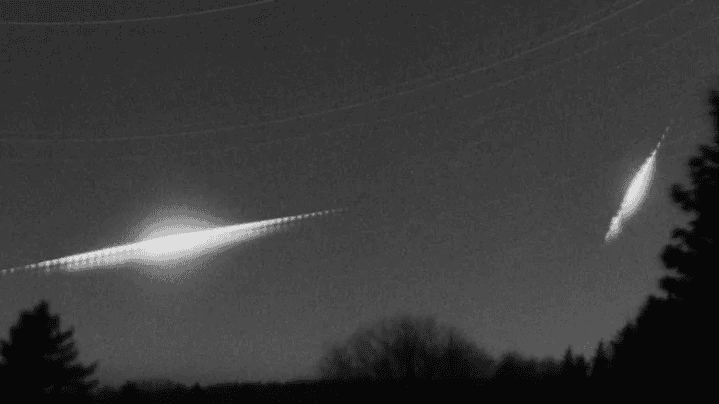
‘There’s this potential for regular bombardment,’ researcher says
Over the past few decades, astronomers have wondered if a nearby swarm of material — one through which Earth crosses — may hold rocks that could pose a danger to people on Earth.
Now a Canadian research team is calling for closer examination of this region, called the Taurid meteor swarm, as it prepares for its closest pass in more than 40 years during an upcoming meteor shower in June.
David Clark, Peter Brown and Paul Weigert, of Western University in London, Ont., have published a paper in the online repository arXiv.org, outlining the best time for astronomers to search the Taurid meteor swarm for any sign of large, dangerous rocks. The paper has also been accepted for publication in the journal Monthly Notices of the Royal Astronomical Society.
“In the next month or so, we’re going to be making the closest pass to the centre of this Taurid swarm — the closest we’ve made since 1975,” said Brown, a professor of physics and astronomy at Western.
“So for the first time with modern instruments, we can actually test the hypothesis that there’s all this very dense material, home to tens [of metres] to hundreds of metres-sized objects, by actually looking … at that centre.”

Though meteors can be seen on any given night, we also get meteor showers, or times of increased activity. There is, on average, a major meteor shower almost every month; they happen because Earth is plowing through debris left behind by a passing comet or asteroid.
The Taurids — associated with the Comet 2P, or Encke — are meteor showers that occur twice a year: Once in June (during the day) and again in October through November (at night).
It’s also believed that Comet Encke is a piece of a larger comet that broke apart, creating a pile of debris that is being held in its orbit by Jupiter’s gravity. This pile is massive: Roughly 75 million kilometres by 150 million kilometres — a ribbon of rocks going around the sun.
Few of the meteors we see in the night sky reach the ground, instead burning up in our atmosphere.
But that isn’t always true for some of the larger rocks, like the 20-metre-wide object that exploded over Chelyabinsk, Russia in 2013, injuring more than 1,000 people after an accompanying air burst caused windows to explode.

Finding clues
Some astronomers, including Brown and his team, believe the core of the Taurid swarm could be hiding Chelyabinsk-sized rocks — or larger. And if it is, it could mean that Earth is likely to experience a large space rock exploding in the atmosphere more often than once in a thousand years, as is the current belief.
The largest impact event ever recorded on Earth took place on June 30, 1908, when the sky over central Siberia seemed as though it had been set afire and a loud bang echoed across the forested landscape.
An occurrence now known as the Tunguska event, it saw a 37-metre-wide, 100,000-kilogram rock enter our atmosphere, travelling at 54,000 km/h, and explode, releasing energy equivalent to 185 Hiroshima bombs.
It’s believed to have flattened more than 80 million trees.

Brown and others believe the Tunguska meteor was consistent with the Taurid meteor swarm.
More recently, in 2015, the orbits of two large asteroids — one measuring 250 metres in diameter — were traced back to the Taurid meteor swarm, further strengthening the argument.
‘Potential for regular bombardment’
Astronomers and telescopic sky surveys, however, have already found about 90 per cent of objects large enough that they would cause damage should they collide with Earth. These near-Earth objects, or NEOs, typically originate from two areas: the asteroid belt between Mars and Jupiter, and the Kuiper belt, beyond the orbit of Pluto.
But the rocks that could be lurking in the Taurids would be very different.
“The Taurid swarm is a totally different animal. It’s suspected of having relatively large objects, from 100 metres to one kilometre … and they’re clustered, so they’re not hitting at random times,” said the paper’s lead author, David Clark.
“There’s this potential for regular bombardment. That just changes the stats altogether, both from what’s the probability of us getting hit by something … [to] the distribution. It’s a regular pounding.”
Looking ahead
While this June will mark the closest that Earth has passed to the swarm since 1975, even closer passes are still to come — in 2032 and 2036.
According to Brown, that could be worrisome.
“If the hypothesis of the Taurid swarm being really, really dense is correct, it means, in fact, the impact hazard to Earth may not be a random … process,” said Brown. “In fact, there may be periods of time where the impact hazard is thousands or millions of times greater than the random background [meteors], and there are very specific intervals where we should be concerned about impacts.”
However, these intervals might only come once every century, said Brown.
Finding these large objects will be a challenge, as they will be quite dim. But both Clark and Brown hope to get some time on large telescopes capable of handling the challenge.
Whether or not large objects are found during the June shower, Clark believes the swarm is worthy of further study.
“If we’re talking a 100-metre object, we’re not talking civilization-destroying event. But we’re talking a potential Tunguska ground-clearing event over Toronto, over New York City. It would be a disaster,” Clark said. “It behooves us to understand these objects.”


